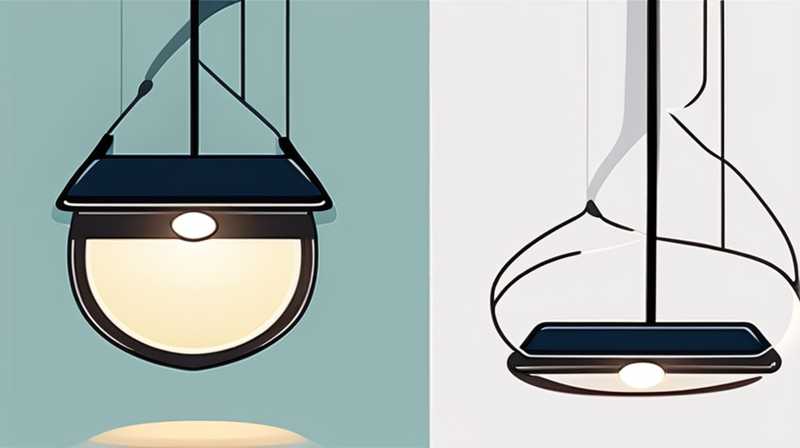
How to light up solar light string
1. Select an appropriate location, 2. Ensure proper connection, 3. Direct sunlight exposure, 4. Consider seasonal adjustments.
To effectively utilize solar light strings, the placement should be in an area with maximum sun exposure, ideally where sunlight is unobstructed throughout the day. This ensures that the solar panel has the best chance to collect energy and fully charge the batteries that power the lights. Additionally, proper connection to ensure that all components are working together will also contribute to the efficiency of the lighting system. Understanding these critical factors enables one to fully harness the potential of solar-powered string lights.
1. SELECT AN APPROPRIATE LOCATION
When positioning solar light strings, the location is paramount. Factors such as sunlight patterns, seasonal changes, and potential obstructions can have significant effects on performance. For optimal charging, place solar panels in areas where they will receive uninterrupted sunlight for the majority of the day. Locations near buildings, trees, or other structures can cast shadows that inhibit solar panel efficacy, so potential placement should be scrutinized.
Apart from sunlight exposure, the aesthetic impact of the chosen location can enhance visual appeal. Solar light strings can be used creatively along pathways, patios, or gardens. Thoughtful placement can create inviting atmospheres and improve the usability of outdoor spaces throughout the evening.
2. ENSURE PROPER CONNECTION
Proper connection of solar light strings ensures maximum efficacy and longevity. Understanding the components of solar light strings is essential, as these systems include solar panels, batteries, wiring, and lights. Misconnections can lead to insufficient power transfer or even damage components. Always refer to the manufacturer’s instructions for connection guidelines.
Additionally, cleanliness can impact connectivity. Dust, debris, or moisture can accumulate on solar panels and connectors over time, reducing efficiency. Regular checks for clean connections and unobstructed solar panels can significantly improve the performance and lifespan of solar string lights.
3. DIRECT SUNLIGHT EXPOSURE
The importance of direct sunlight exposure cannot be understated. Solar light strings rely on photovoltaic cells to convert sunlight into electrical energy. The intensity and duration of sunlight directly correlate with how efficiently these cells can perform. Depending on geographic location, light exposure can vary significantly, impacting the overall effectiveness of solar lighting solutions.
Moreover, it is essential to consider seasonal adjustments in sun exposure. In winter months, the sun’s angle changes, reducing the overall sunlight on solar panels. Therefore, it may be necessary to reposition lights for effective charging during these periods. Awareness of these seasonal variations will ensure consistent performance of solar light strings year-round.
4. CONSIDER SEASONAL ADJUSTMENTS
Seasonal adjustments are critical for optimal solar light performance. As the seasons change, sunlight patterns alter, which directly affects the solar panels’ ability to charge effectively. In summer, the longer days typically provide ample sunlight, but adjustments may be required as autumn progresses and daylight hours decrease.
Moreover, during winter, the low angle of the sun could warrant repositioning the solar panels for enhanced exposure. Taking time to assess the installation periodically ensures that the solar lights continue to function efficiently regardless of seasonal changes. Proactive maintenance amplifies the overall benefits of solar light strings.
FAQs
HOW LONG DO SOLAR STRING LIGHTS LAST?
The lifespan of solar string lights varies widely based on the quality of the materials and how they are maintained. Typically, LEDs can last for over 20,000 hours, while the solar panels often have a lifespan of approximately 5 to 10 years. Battery life, which typically lasts between 2 to 4 years, is crucial since the battery’s efficiency will significantly affect the string lights’ performance. Regular maintenance, such as cleaning the solar panels to remove dust and ensuring that the battery is in good condition, can extend the life expectancy of these lights. If the solar light string shows signs of reduced brightness or inconsistent operation, it may be time to seek replacements for batteries or entire units.
CAN SOLAR STRING LIGHTS WORK ON A CLOUDY DAY?
Yes, solar string lights can function on cloudy days, however, their performance may be reduced compared to sunny conditions. Photovoltaic cells are designed to capture available sunlight, albeit at a lower efficiency when the sun is obscured. While direct bright sunlight provides optimal charging, diffused light on cloudy days still allows for some energy production. It is worth noting that solar lights may need more time to charge fully and may not shine as brightly in comparison. To maintain consistent illumination, it is advisable to allow these lights to fully charge during clearer days, ensuring they have accessed their maximum potential.
HOW DO I CLEAN MY SOLAR LIGHTS?
Cleaning solar lights is an essential maintenance practice that affects their efficiency significantly. Dust, dirt, and debris can accumulate on the solar panels, obstructing sunlight from reaching the photovoltaic cells. To clean solar lights, it is best to use a soft cloth or sponge with mild soap and water. Gently scrub the panel surfaces, ensuring that every crevice is attended to without scratching them. Additionally, check for any foliage or dirt surrounding the installations that may block sunlight. Regular cleaning ensures that solar lights operate at optimal levels, ultimately improving their performance and longevity.
Utilizing solar light strings efficiently requires a strategic approach. By selecting optimal locations, ensuring proper connections, maximizing sunlight exposure, and adjusting for seasonal changes, one can unlock the full potential of these energy-efficient lighting solutions. This benefits not only the environment by reducing carbon footprints but also enhances the outdoor experience with beautiful illuminations. Engaging in proper maintenance, including cleaning and monitoring the system, prolongs the life of the lights and allows users to enjoy them season after season. With these practices in mind, anyone can successfully brighten their outdoor spaces with ease and style.
Original article by NenPower, If reposted, please credit the source: https://nenpower.com/blog/how-to-light-up-solar-light-string/


